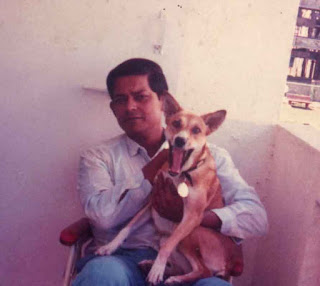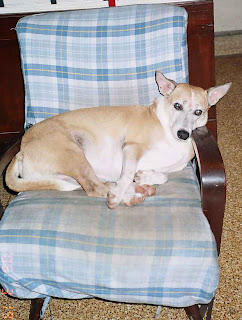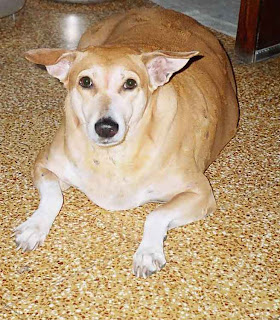A yellowish form slides across a busy city street, expertly
evading the heavy traffic, and dives into a dustbin on the other side,
nosing about for edible scraps. It is a dog, medium sized, a dull yellow
in colour, mangy in places, with brown eyes just as dull as his skin.
He is lean and ribby, and undoubtedly has worms. Ticks and fleas
infest his body. Nobody owns him, nobody cares for him, he finds his
own food, water, and shelter. Under conditions which would have killed
any of his domestic relatives, he lives, and, indeed, flourishes
to the extent that he reproduces.
Around the corner of the street, hidden in the ditch, lies a bitch,
with six pups fighting for her milk. She will have to feed herself,
sufficiently so as to give life-sustaining nourishment to her pups.
Out of the six, perhaps two will survive, the others being taken by
disease, traffic, and many other hazards that are all too eager to
take the lives of young pups.
What does all this tell us? The pariah, or pi dog is hardy,
intelligent, and a survivor. The weak and unfit have been taken; the
law of the survival of the fittest is inexorable, and, through the
ages, the pi dog has all the qualities needed to survive.
Pick up a pup at the age of about six weeks. Its mother has already
started the weaning process by regurgitating food for it - half
digested, the young one finds it easier to digest. Take the pup home,
deworm it - it is sure to have roundworms if not tapeworms - treat it for
ticks and fleas, and give it a good brushing, if not a bath. Feed it
regularly, starting with dilute milk and perhaps hard-boiled eggs,
chopped up. Later, it will even do well on kitchen scraps.
The dull coat will begin to shine, depending on the colour, a warm
golden yellow, a deep black, or a flaming apricot-red, the dry skin
will become supple, the lifeless eyes will turn a warm, trusting brown
as they look up to you.
What have you got for your trouble? A wonderful companion for free.
Consider this: if you can shake off the misconception that pi dogs are
ugly, you will find they are not. Beauty is in the eye of the
beholder, and many breeds admitted by the Kennel Club look remarkably
like the pi - the Basenji and the Canaan dog being two examples.
Looks are, after all, only skin deep, so what have they under the
skin? Hardihood, for one. As mentioned before, they come from
generations of creatures who have fought for survival amid the
toughest conditions, and the hardiest have made it. They will thrive
on food which softer dogs won't touch. They are remarkably resistant
to disease, and when ill, respond very quickly to treatment . I had
one which was mauled by a leopard, and recovered, with proper
treatment, in eleven days. But more of that later.
Loyalty and love for the master is another grand attribute. An old
and poor woman at the edge of the town sets out a bowl of scraps
outside her door. A big, black and white pi comes for it, cleans up
the bowl, and returns to his station just beside the doorway. Woe
betide any unwelcome intruder. Big Jim will soon send him on his way.
I have had, and still have, pi dogs as companions and guards. When
I am sitting by myself, often I will have a cold nose thrust into my
hand , asking for affection, and warm brown eyes look up lovingly and
trustingly into mine.
Intelligence, coupled with courage, is bred into them. They can be
taught surprisingly quickly, and pick up new ideas on their own. At
one time I had, among others, two, Koila and Harnol, who were
particular friends. Koila was my own dog; Harnol, his younger brother
was fed by me but stayed at a forest chowki a quarter of a mile away.
One day, Harnol came to the forest guard and started whining and
whimpering, running away a few steps, and returning to the man.
Thinking the dog was hungry (it was lunchtime) the guard gave him a bit
of 'roti', but Harnol ignored it, and began tugging gently at the man's
sleeve. Realising the dog wanted him to follow, the man did so, and
Harnol led him to a patch of undergrowth where his friend, Koila was
held fast in a poacher's wire snare. Koila was lying quietly and had
not, therefore, hurt himself and the guard released him without
trouble. Great was the gratitude and joy of both dogs!
Harnol, indeed was the victim of the leopard mentioned earlier. There
were seven of these dogs roaming the grounds, in the night, when a
smallish leopard picked up Harnol and attempted to carry him off. The
rest of them gave chase, and, unable to defend itself as well as carry
off his prey, the cat released the dog and made its escape.
Bhalu, the mother of both Koila and Harnol, was a small, black dog.
One night, a herd of cattle got into my crops, and my servants, aided
by Bhalu, got the bovines cornered. The next day the people had to
go for their regular chores, but Bhalu (self taught) circled the herd
and would not let them scatter until the Gujjar owner came and
negotiated with me for their release. There are many tales of Bhalu's
loyalty, courage and intelligence, too many to be detailed here.
As a rule, the Pi's courage is not a heedless, reckless one, but is
tempered with caution. It will bark at a suspicious character from a
distance, rather than rush in to attack and bite. I, certainly, prefer this
behaviour; it is too embarrassing and inconvenient to have friends and
casual visitors bitten - a warning is much more satisfactory. Nevertheless,
when the master is actually in danger, the dog will risk its own life to defend him.
If you are looking for a loving companion who can also protect your
property, you could do a lot worse than choose a pi dog. Love it, look
after it, and it will repay you a thousand times over.
S. Chaudhuri
Hardwar

















